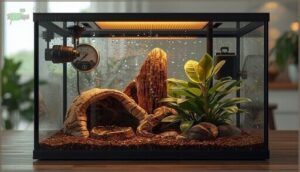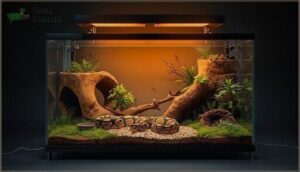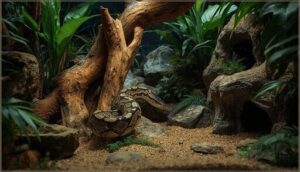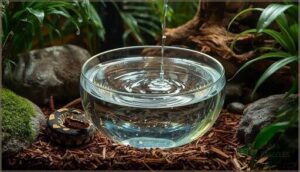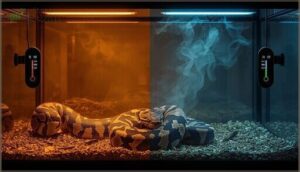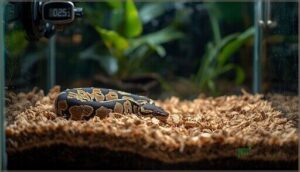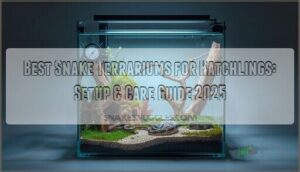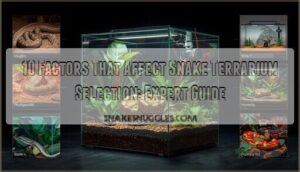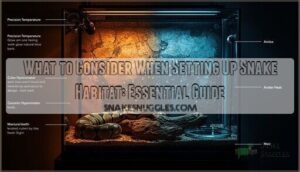This site is supported by our readers. We may earn a commission, at no cost to you, if you purchase through links.
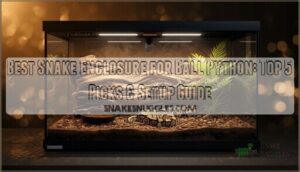
PVC enclosures do a much better job holding in heat and humidity compared to glass tanks, so it’s easier to keep your snake’s environment just right.
Glass lets you see your snake more easily, but you’ll need to put in extra work to keep the setup stable.
Make sure your enclosure has enough room for your snake to move around, a couple of good hiding spots, and a temperature range—88-92°F on the warm end and 78-80°F on the cooler side.
Pick what works based on your snake’s size and how much effort you want to put into managing the environment.
Table Of Contents
- Key Takeaways
- Best Snake Enclosures for Ball Pythons
- Setting Up a Ball Python Enclosure
- Essential Features for a Ball Python Enclosure
- Creating The Perfect Ball Python Tank Setup
- Frequently Asked Questions (FAQs)
- What is the best snake enclosure for a ball python?
- What is the best snake enclosure?
- Where can I buy a ball python enclosure?
- What is the best substrate for a ball python enclosure?
- Do ball pythons need different enclosure sizes?
- How hot should a ball python enclosure be?
- Which Terrarium is best for a ball python enclosure?
- What type of enclosure is best for ball python?
- What is the proper tank for a ball python?
- What kind of cage does a ball python need?
- Conclusion
Key Takeaways
- Adult ball pythons need enclosures at least 48 inches long with 8 square feet of floor space, while juveniles thrive in 40-gallon setups—matching tank size to your snake’s current length prevents stress and supports natural movement. – PVC enclosures retain heat and humidity 20-30% better than glass alternatives, making environmental control easier and reducing your daily maintenance work, though glass offers better visibility if you’re willing to monitor conditions more closely. – Your setup must include a thermal gradient with basking spots at 88-92°F and cool zones at 78-80°F, plus humidity between 60-80% using moisture-retentive substrate like coconut husk—these conditions directly impact digestion, shedding, and respiratory health. – Front-opening doors with secure locks and at least two hiding spots (one warm side, one cool side) create both escape-proof security and stress-reducing privacy your ball python needs to feel safe and behave naturally.
Best Snake Enclosures for Ball Pythons
Picking an enclosure for your ball python? Size matters, but it’s not the whole story.
You need a space that feels safe to your snake—one that works with how they naturally move, hide, and regulate their body temperature.
The best terrariums combine proper dimensions with features like front-opening access, reliable heat retention, and escape-proof locks to give your snake the environment they need to thrive.
1. Large Reptile Terrarium Easy Assembly
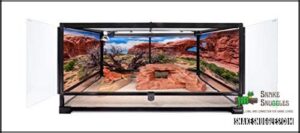
Quick setup means less stress for you and your ball python. The Reptizoo NRK Series terrarium uses a 4-step folding process with pre-installed door frames, so you can have your ball python enclosure ready in under 10 minutes.
Some large reptile terrarium models feature pre-machined panels and simple hardware that eliminate complicated assembly steps. These easy assembly designs include front-opening doors with secure locking mechanisms to prevent escapes while giving you quick access during feeding and maintenance.
PVC panel options reduce setup time by 40% compared to glass alternatives and hold heat better for your snake’s comfort. You’ll find removable bedding trays that make substrate changes take less than 5 minutes, and stackable designs that save household space when you’re managing multiple reptile habitats.
Best For: Ball python owners and reptile keepers who want a spacious, low-maintenance enclosure that sets up quickly and holds heat well.
- Fast assembly in under 10 minutes with pre-installed components and simple 4-step folding process
- PVC construction retains heat 30% better than glass, reducing energy costs and maintaining stable temperatures for ball pythons
- Front-opening doors with secure locks provide easy access for feeding and cleaning while preventing escapes
- Doors may not open fully if placed on same-size racks, limiting access during maintenance
- Not suitable for aquatic reptiles that need swimming space despite waterproof base
- Glass models lose heat quickly, increasing heating costs by approximately 25% compared to insulated alternatives
2. 67 Gallon Reptile Terrarium Glass
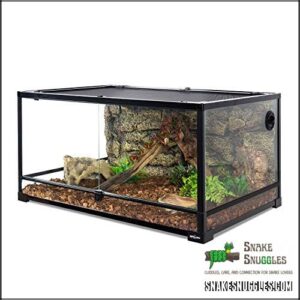
The 67 Gallon Reptile Terrarium Glass offers a reliable home for your adult ball python. This large reptile terrarium features glass construction that holds heat effectively and maintains humidity between 55% and 70%. The double front doors with secure locking mechanisms prevent escapes while making feeding and cleaning straightforward.
The ventilated mesh top lets UVB and infrared light through while keeping air moving.
The raised bottom frame fits under-tank heaters, so you can set up the temperature gradient your snake needs.
At 36 x 24 x 18 inches, this reptile enclosure provides adequate floor space for your snake. The waterproof bottom accommodates various terrarium setups. Assembly takes about five minutes, though some customers reported missing screws. Glass enclosures like this one clean easily and resist bacterial buildup.
Best For: Adult ball python owners who want a spacious, easy-to-clean glass enclosure with good humidity control and thermal gradient management.
- Glass construction maintains humidity levels (55-70%) and temperature gradients effectively, with a ventilated mesh top that allows UVB and infrared penetration
- Double front doors with secure locks make feeding and cleaning simple while preventing escapes
- Quick 5-minute assembly with raised bottom frame for under-tank heaters and waterproof base for flexible terrarium setups
- Some customers report missing parts like screws upon delivery
- Glass can lose humidity faster than PVC alternatives, requiring more frequent monitoring with hygrometers
- May need additional insulation on three sides to reduce visual stress for ball pythons
3. Large Reptile Terrarium Glass Tank
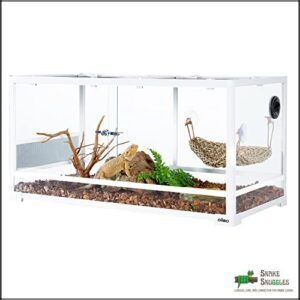
Moving beyond the 67-gallon option, you’ll find glass tanks around the 50-gallon range that work well for ball pythons under three feet long. These Large Reptile Terrarium Glass Tanks feature tempered glass construction that’s durable and easy to clean during routine Glass Tank Maintenance. The mesh top provides Large Tank Ventilation while allowing Terrarium Lighting and UV penetration for a healthy reptile enclosure.
Your ball python enclosure benefits from the transparency, letting you observe your snake’s behavior without disturbing it. However, glass struggles with humidity retention compared to PVC alternatives. You’ll need to cover about 75% of the screen top with HVAC tape and use moisture-retentive substrate like coconut husk to maintain the 55-70% humidity range ball pythons require.
The sliding doors lock tight, so your snake stays put during feeding time or when you’re rearranging things.
You’ll need a second person and some basic tools to put it together, but once assembled, it holds heat gradients well enough to keep your ball python comfortable.
Best For: Ball python owners who want a clear view of their snake and don’t mind adjusting humidity levels with mesh covers and substrate choices.
- Tempered glass construction is durable and makes cleaning straightforward, with sliding doors that lock securely to prevent escapes during feeding or maintenance.
- Full transparency lets you watch your snake’s natural behavior without disturbing it, while the mesh top allows UV lighting to penetrate for proper health.
- Assembly is manageable with basic tools and a second person, resulting in a functional setup that maintains temperature gradients across the 48″L x 18″W x 18″H space.
- Glass loses humidity faster than PVC enclosures, requiring you to cover roughly 75% of the screen top with HVAC tape and use moisture-holding substrate to hit the 55-70% range ball pythons need.
- The 67-gallon capacity works for snakes under three feet, but larger adults over three feet require bigger enclosures with at least 8 square feet of floor space.
- Heat retention isn’t as efficient as solid-walled alternatives, so you’ll need to insulate three sides with foam board to minimize temperature fluctuations.
4. Large Reptile Tank 85 Gallon
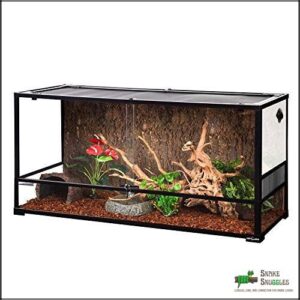
The 85-gallon large reptile tank offers your ball python room to thrive. This enclosure measures 48 inches long and provides over 5,000 square inches of floor space—well beyond the 40-gallon minimum for adults. Its tempered glass construction ensures tank maintenance stays simple, while the front-opening doors give you safe access during feeding.
The raised bottom frame fits substrate heaters perfectly for thermal regulation, letting you create that critical warm-to-cool gradient. Screen ventilation balances humidity control with airflow, and enclosure security comes standard with anti-escape locks.
You’ll maintain proper reptile health by monitoring conditions through the wire inlets, making this ball python enclosure adaptable for your snake’s changing needs.
Best For: Ball python owners wanting a spacious, secure enclosure that simplifies humidity control and thermal regulation for adult snakes.
- Over 5,000 square inches of floor space allows natural movement and multiple enrichment zones beyond minimum requirements
- Tempered glass construction with raised frame accommodates substrate heaters and maintains humidity while staying easy to clean
- Front-opening doors and wire inlets make feeding, maintenance, and equipment installation straightforward and secure
- Sliding doors may rattle and the locking mechanism can be bypassed with thin objects, requiring DIY improvements for true security
- Screen top needs partial covering (80-90%) to maintain proper humidity levels, adding extra setup steps
- Glass transparency can stress ball pythons unless you cover three sides with opaque material to create a secure feeling
5. Large Reptile Terrarium Chameleon Cage
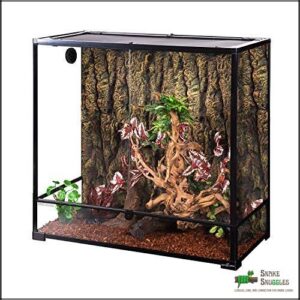
This enclosure raises an important concern. While marketed as a chameleon cage, mesh-sided terrariums are fundamentally unsuitable for ball pythons. These cages feature screen panels that promote rapid airflow—ideal for arboreal lizards but disastrous for humidity-dependent snakes.
Ball pythons require 60-80% humidity, yet mesh enclosures struggle to maintain even 40% in dry climates. The open construction also fails to retain heat, disrupting the thermal gradient your snake needs.
Additionally, flexible acrylic doors and mesh panels pose escape risks for heavy-bodied constrictors. Survey data shows less than 8% of ball python keepers use mesh cages as primary enclosures, and for good reason.
Your ball python needs a secure glass terrarium or PVC enclosure—not a ventilated chameleon habitat. Choose a proper 40-gallon or larger glass enclosure with front-opening doors instead.
Best For: Arboreal reptile keepers with chameleons or tree-dwelling lizards who need vertical space and ventilation—not for ball pythons or humidity-dependent species.
- Spacious 36″L x 18″W x 36″H design provides 23,328 cubic inches of room for large arboreal reptiles to climb and explore
- Front-opening tempered glass doors with security locks allow easy access for feeding and cleaning while preventing escapes
- 360° full-view glass construction and wire organization system create an attractive display setup for observing active lizards
- Mesh and screen design causes rapid humidity loss, making it unsuitable for ball pythons or other snakes requiring 60-80% humidity levels
- Quality control issues reported with assembly instructions, tempered glass defects, and locking mechanisms that may fail
- Flexible materials and ventilated construction pose escape risks for heavy-bodied constrictors, with inadequate thermal retention for heat-dependent species
Setting Up a Ball Python Enclosure
Get your ball python’s home right the first time—it saves you headaches down the road and keeps your snake happy.
You’ll need to balance enclosure size with your python’s age, establish proper temperature zones, and add security features that keep your pet safe while making daily care manageable.
Choosing The Right Enclosure Size and Type
When you’re choosing an enclosure for your ball python, size matters more than you might think. Hatchlings under 17 inches do well in 10-gallon tanks, but juveniles need at least 20 gallons once they pass 20 inches. Adult ball pythons over 3 feet require a minimum of 48 inches long by 24 inches wide, which equals roughly 65-75 gallons. Your enclosure dimensions should match your snake’s growth stages to prevent stress and encourage healthy movement.
Here’s the thing about materials: PVC enclosures hold heat and humidity 20-30% better than glass tanks, so you won’t be misting constantly to keep conditions stable.
Glass looks great and lets you watch your snake, but it takes more effort to maintain the right environment.
Either option works fine as long as you get lockable doors—ball pythons are escape artists who’ll test every weakness in their setup.
A proper temperature gradient is also essential for their well-being. Choosing ball python enclosures based on your snake’s current size and your ability to control temperature keeps your pet thriving.
Designing The Perfect Ball Python Environment
Once you’ve nailed down the right size, the real work begins—turning that empty glass box into a thriving home your ball python will actually use. Focus on three core elements:
- Thermal gradient: Install heat sources to create warm basking zones (90-95°F) and cooler areas (78-80°F).
- Humidity control: Maintain 60-70% levels using moisture-retentive substrate selection like coconut husk or cypress mulch.
- Enrichment items: Add multiple hiding spots, branches, and visual barriers throughout the enclosure.
Ensuring Safety and Security Features
Your ball python’s enclosure needs to be as secure as a bank vault—because even the most docile snake is a master escape artist. Install lockable latches on all doors. These secure latches provide tamper resistance and essential enclosure features for escape prevention.
| Security Feature | Purpose | Implementation |
|---|---|---|
| Antiescape locks | Prevent door opening | Install on all access points |
| Durable materials | Resist damage over time | Use tempered glass or PVC |
| Tight-fitting lids | Block gap escapes | Make sure no spaces exceed 0.25 inches |
Childproofing your enclosure design protects both your snake and curious hands. An escape-proof setup guarantees safety and security for years.
Selecting The Correct Dimensions and Material
Getting the size and material right makes a real difference for your ball python. Once they hit 3 feet, you’re looking at a minimum 48-inch enclosure with at least 8 square feet of floor space.
PVC holds heat 20% longer than glass and handles humidity without warping. Glass looks great and shows off your snake, but you’ll burn more energy keeping temperatures stable. Both clean up easily enough, though PVC’s non-porous surface stops bacteria from getting a foothold and keeps humidity more consistent. PVC enclosures also let you place vents wherever they work best for airflow.
Considering Lighting and Enrichment Options
Light isn’t just about seeing your snake—it’s about creating the right environment for your ball python to thrive. UVB lighting promotes natural behaviors and calcium metabolism. Pair it with basking lamps to maintain proper thermal gradients.
Enrichment keeps your python engaged and reduces stress:
- Hiding spots with terrarium backgrounds create security
- Climbing branches encourage natural exploration
- Puzzle feeders provide sensory enrichment during meals
A UVB bulb mimics daylight cycles your snake needs for healthy functioning.
Essential Features for a Ball Python Enclosure
A good enclosure does more than keep your ball python from wandering off. It needs to trap heat properly, keep humidity stable, and give your snake spots to feel secure—all while being practical enough that you’re not wrestling with it during feeding time or cleanings.
The best setups combine enough floor space with features that actually work—materials that hold heat, humidity levels that don’t swing wildly, and hide spots that make your python feel safe while keeping daily maintenance simple.
Sufficient Floor Space for Your Ball Python
Floor space isn’t just about fitting your snake—it’s about letting them move, explore, and behave naturally. Adult ball pythons need at least 8 square feet of floor space to stretch fully and thrive.
A 40-gallon tank works for juveniles, but adults require larger enclosure dimensions. Your python’s comfort depends on choosing the right terrarium size that accommodates natural snake movement without causing stress.
Holds Heat and Maintains Humidity
Heat retention and humidity control work together to keep your ball python healthy. Glass terrariums hold heat well, but you’ll need to cover 80-90% of the screen top to prevent humidity from dropping below 60%. PVC enclosures retain moisture 25% better than glass, requiring less daily misting.
- Use moisture-retentive substrates like sphagnum moss or coco chips at least 4 inches deep
- Maintain humidity levels between 60-80% with a hygrometer for accurate monitoring
- Create thermal gradients with a basking spot at 95°F and a cool side around 80°F
- Place large water bowls under heat sources to boost humidity through natural evaporation
Easy Access for Feeding and Maintenance
Once you’ve nailed humidity and heat, the right door design transforms daily care from a wrestling match into a smooth, stress-free routine. Front-opening doors with secure latches let you feed and clean without disturbing your snake.
Double-hinge or sliding doors paired with anti-escape locks prevent breakouts while simplifying maintenance routines. Access panels make spot-cleaning quick, keeping your enclosure size working for you, not against you.
Providing Hiding Spots and Visual Barriers
Your ball python needs places to disappear when the world feels too big. Provide at least two hiding spots per enclosure—one on the warm side and one on the cool side.
Visual barriers like artificial foliage or logs reduce stress and encourage natural behaviors. These terrarium decorations create environmental enrichment while helping with thermoregulation.
Choose options sized appropriately for your enclosure size and substrate depth.
Creating a Thermal Gradient for a Healthy Environment
Ball pythons depend on external heat for every bodily function. You need to build a thermal gradient with a warm side at 88–95°F and a cool zone at 75–80°F. This temperature control lets your snake thermoregulate naturally by moving between zones.
Use a heat pad with a thermostat on one end and a ceramic heat emitter or heat lamp for the basking spot. Monitor both surface and air temperatures with digital thermometers. Proper heat sources prevent respiratory infections and boost feeding response by up to 35%.
| Zone | Temperature Range | Purpose |
|---|---|---|
| Basking Spot | 88–95°F | Digestion and metabolic function |
| Cool Side | 75–80°F | Heat escape and stress reduction |
| Nighttime | 75–78°F | Natural circadian rhythm maintenance |
Creating The Perfect Ball Python Tank Setup
Setting up your ball python’s tank isn’t just about dropping in a heat lamp and calling it done. You need the right balance of space, temperature zones, hiding spots, hydration access, and substrate to create a home where your snake can thrive.
Providing Plenty of Space for Your Ball Python
Space isn’t just about square footage—it’s about giving your ball python room to stretch, explore, and feel secure in its own territory. Adult ball pythons need an enclosure size matching their body length—usually 4 feet long minimum. A 40-gallon tank works for juveniles, but adults require larger habitat setups around 75-120 gallons.
Adequate terrarium size facilitates natural snake movement patterns and reduces stress. Focus on enclosure depth and floor space rather than height, since ball pythons are ground-dwellers. The right ball python enclosure creates a foundation for proper temperature zones and overall health.
Using Decorations for Hiding Spots and Enrichment
Decorations transform a bare enclosure into a space where your ball python can thrive, not just survive. Strategic placement of hiding spots reduces stress and encourages natural behaviors.
- Cork bark rounds for secure retreats
- Decorative rocks creating visual barriers
- Plant arrangements with artificial foliage
- Multiple caves positioned on both substrate ends
- Climbing branches for enrichment activities
These additions make your terrarium feel safe while promoting healthy exploration throughout the ball python enclosure.
Creating a Hydration Station for Your Ball Python
Water isn’t just a drink for your ball python—it’s a lifeline that sustains hydration, shedding, and overall health. Choose a water bowl large enough for your snake to soak in but shallow enough to prevent drowning. Place it on the cooler side of the enclosure to help maintain humidity levels without disrupting the temperature gradient.
Change the water daily to guarantee water quality and encourage proper drinking behavior. Clean the bowl weekly to prevent bacterial growth that could affect your snake’s hydration and substrate cleanliness.
Monitoring The Temperature Gradient for a Healthy Environment
Keeping the right temperatures isn’t just a detail—it’s how your ball python stays healthy.
Without a good heat gradient, your snake can struggle to digest food or fight off illness, so you want to track temps closely across the whole setup.
Here’s your setup for effective gradient management:
- Place digital thermometers at both the warm and cool ends to track temperature control accurately. 2. Create a basking spot reaching 88-92°F using overhead heat sources like ceramic emitters. 3. Maintain the cool zone at 78-80°F for ideal heat retention without overheating. 4. Monitor humidity levels at 60-80% alongside your thermal gradient for complete temperature and humidity control.
Choosing The Right Substrate for Your Ball Python Enclosure
Substrate choice directly impacts your ball python’s respiratory health and humidity control. Coconut coir and coconut husk are proven substrate materials that maintain 60-80% humidity without molding. Use a four-inch layer to sustain moisture retention and allow natural burrowing options.
Avoid pine and cedar—their aromatic oils damage airways. Paper-based substrates work for easy cleaning but don’t sustain species-typical behavior.
Natural substrates paired with proper temperature gradient create the healthiest environment for your snake.
Frequently Asked Questions (FAQs)
What is the best snake enclosure for a ball python?
When choosing a ball python enclosure, prioritize a glass terrarium with front-opening doors and secure locks.
A 4x2x2 foot setup provides the space your snake needs while maintaining proper humidity control and ventilation systems for healthy snake behavior.
What is the best snake enclosure?
The snake enclosure you pick really matters for your pet’s health. PVC or glass terrariums with front-opening doors are your best bet—they hold humidity and temperature way better than other options.
Consider these critical enclosure materials factors:
- Tank security features – Secure latches prevent escapes and guarantee your snake habitat remains a safe vivarium
- Heat and moisture retention – Glass terrarium walls hold warmth better than mesh alternatives for proper reptile habitat conditions
- Dimensions matter – Select an enclosure at least 5 times your snake’s body length to facilitate natural movement and behavior
Where can I buy a ball python enclosure?
Where should you turn when looking for the right terrarium? Local reptile stores offer hands-on inspection of glass terrariums and PVC enclosures.
Online retailers like Carolina Custom Cages Terrarium provide extensive selections.
Reptile expos connect you with custom builders and breeder recommendations for specialized ball python enclosures.
What is the best substrate for a ball python enclosure?
Your ball python needs substrate that balances humidity levels with mold resistance and odor control. The right substrate material aids shedding success while remaining cost-effective for long-term maintenance.
Top substrate options include:
- Cypress mulch – Excellent substrate humidity retention and natural appearance with strong mold resistance
- Coconut husk – Moisture-holding natural substrates that promote proper shedding cycles
- Aspen shavings – Affordable substrate material offering decent odor control but lower humidity maintenance
- Paper-based bedding – Clean substrate options ideal for monitoring health and quick spot-cleaning
- Reptile soil blends – Bioactive-ready substrate combining humidity control with naturalistic enrichment
Do ball pythons need different enclosure sizes?
Yes, ball pythons need different enclosure sizes based on their age and length. Hatchlings thrive in 10-gallon tanks. Juveniles need 40 gallons. Adults over 3 feet require 80-120 gallons minimum for proper welfare.
| Life Stage | Ideal Enclosure Dimensions |
|---|---|
| Hatchling | 10 gallons (20″ x 10″ x 12″) |
| Juvenile (under 3 ft) | 40 gallons (36″ x 18″ x 18″) |
| Adult (over 3 ft) | 80-120 gallons (48″ x 24″ x 24″) |
Overcrowding risks stress in juveniles, while hatchlings feel exposed in oversized spaces. Match tank size to your snake’s current length for best enrichment considerations and healthy growth needs.
How hot should a ball python enclosure be?
Ball pythons are temperature-dependent creatures. Without the right heat zones, they can’t digest food properly, their immune systems weaken, and stress sets in. Your enclosure needs a basking spot between 90-95°F, a warm hide at 90°F, and a cool side around 78-80°F. This gradient isn’t optional—it’s how your snake manages its body temperature throughout the day.
Keep the overall ambient temperature around 82°F. At night, don’t let it drop below 70°F or you’ll stress your snake. Under-tank heaters or ceramic heat emitters work well for consistent warmth. You’ll also want to watch humidity—aim for 60-80%—since it works hand-in-hand with temperature regulation. The right heat source and enclosure materials make maintaining these levels much easier over time.
Which Terrarium is best for a ball python enclosure?
A proper terrarium becomes your ball python’s lifelong home. PVC enclosures measuring 4’x2’x2′ outperform glass terrariums in heat retention and humidity control.
Front-opening doors prevent escape while making feeding safer than top access designs.
What type of enclosure is best for ball python?
Your ball python needs an enclosure it’ll live in for years. PVC setups at 4’x2’x2′ lock in heat and humidity better than glass—plus they’re just easier to work with.
Front doors beat top-opening lids every time, especially when you’re feeding.
- Adequate floor space for natural movement patterns
- Room for proper thermal gradient setup
- Multiple hide locations without overcrowding
- Space for water bowls and enrichment items
This enclosure size fosters healthy behavior without overwhelming your snake.
What is the proper tank for a ball python?
Your ball python needs a PVC enclosure or glass terrarium that matches its body length. A 40-gallon tank works for juveniles, but adults over three feet require larger housing.
The enclosure must maintain a thermal gradient and humidity control while providing secure access.
What kind of cage does a ball python need?
Your ball python needs a secure enclosure made from PVC or glass with front-opening doors. The enclosure size should be at least two-thirds of your snake’s body length. Proper humidity levels and a temperature gradient are essential for health.
Key requirements for your ball python enclosure:
- Material Choice: PVC or glass construction retains heat and maintains humidity levels effectively
- Enclosure Size: Minimum 40 gallons for juveniles, 75-120 gallons for adults over 3 feet
- Security Features: Front-opening doors with secure latches prevent escape attempts
- Thermal Gradient: Create zones from 78°F cool side to 88-92°F warm side for thermoregulation
- Humidity Control: Maintain 60-80% humidity with moisture-retentive substrate and proper ventilation
Conclusion
Your ball python’s future health starts with the right foundation. The best snake enclosure for ball python care delivers proper space, heat retention, and humidity control.
Choose PVC for environmental stability or glass for visibility with extra monitoring.
Make sure your setup includes adequate floor space, thermal gradients, and hiding spots. With the right enclosure and proper setup, you’ll create a thriving habitat your snake deserves for years to come.
- https://www.zillarules.com/all-products/terrariums/quickbuild
- https://reptizoo.store/collections/easy-folding-reptile-terrariumnrk-series
- https://www.visionproducts.us/blog/reptile-enclosure-materials/
- https://www.zenhabitats.com/collections/ball-python-enclosures
- https://apexreptile.com/blogs/apex-reptile-blog/best-material-reptile-cage

